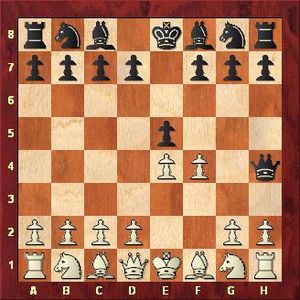UNE VARIANTE MECONNUE DU GAMBIT DU ROI
J'avoue ne pas avoir retenu son nom, mais j'ai découvert cette variante étonnante, qui était dans le répertoire d'ouvertures de mon vieux cyber compagnon Méphisto Polgar. Je l'ai ressortie depuis quelques mois, avec un certain succès. De quoi s'agit-il ? De la suite : 1.e4,e5 2.f4,Dh4+!?

Un coup qui viole les principes d'ouverture et qui a l'air d'un coup de débutant puisque cette sortie de dame, prématurée en apparence, est immédiatement sanctionnée par 3.g3 obligeant au retrait... Le premier petit piège est qu'après 3...De7, les blancs ne peuvent plus jouer le naturel 4.Cf3 sans perdre immédiatement un pion... De plus, la position agressive exercée par la dame sur la colonne e leur permet un développement rapide et déstabilisant, grace au clouage du pion e...
Je vous ai concocté une petite base pgn qui reprend quelques unes de mes parties... et de celles de "vrais" joueurs qui utilisent cette suite. C'est tactiquement riche. Merci de me donner votre avis !




/http%3A%2F%2Fstorage.canalblog.com%2F41%2F35%2F428718%2F76759616_o.jpg)
/http%3A%2F%2Fstorage.canalblog.com%2F02%2F56%2F428718%2F71451409_o.jpg)
/http%3A%2F%2Fstorage.canalblog.com%2F77%2F11%2F428718%2F64897934_o.jpg)
/http%3A%2F%2Fstorage.canalblog.com%2F29%2F98%2F428718%2F63664990_o.jpg)
/https%3A%2F%2Fprofilepics.canalblog.com%2Fprofilepics%2F3%2F6%2F369255.jpg)